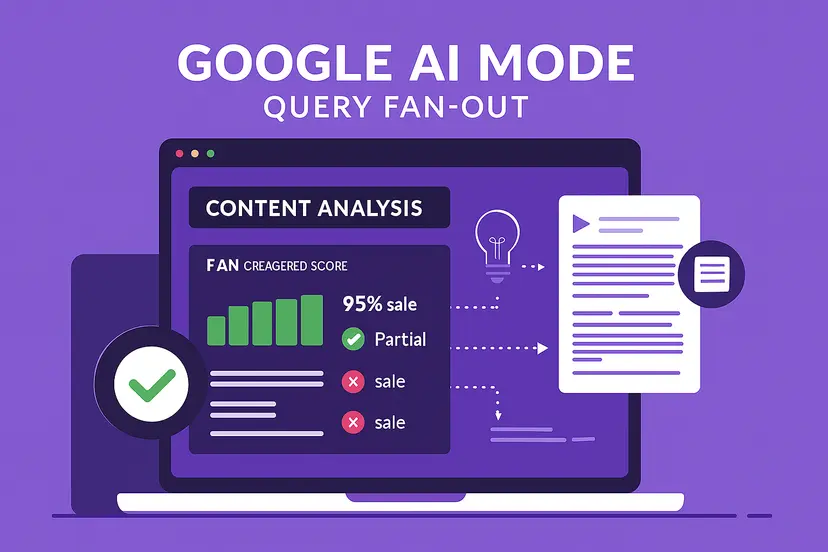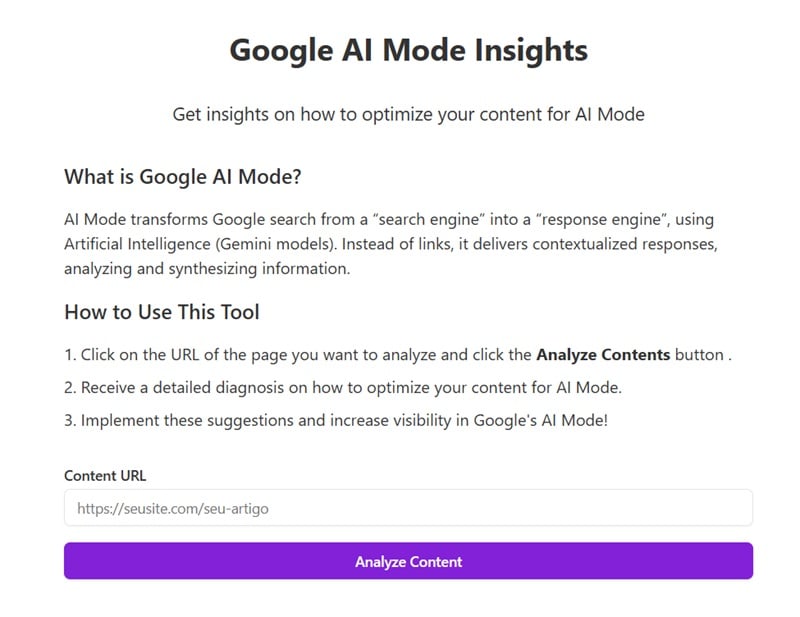Query Fan Out in Google AI mode: What it is and How to Optimize it with Niara’s New Free Tool

Get ready for a radical transformation in Google Search! The landscape is shifting from a simple “search engine” to an “answer engine” propelled by Artificial Intelligence. At the heart of this change is Google AI Mode and a powerful technique known as Query Fan Out, which allows users to explore information more comprehensively and contextually.
While AI Mode is actively rolling out in the US, Niara, as a pioneer, is at the forefront, offering tools that enable SEO and content professionals to prepare today for the future.
Table of Contents
- What is Google AI Mode?
- Unpacking Query Fan Out in AI Mode
- Why Is This Technique Important?
- Practical Example of Query Fan Out
- How to Optimize Your Content for AI Mode’s Query Fan Out (and for AI in General)
- Google’s Commitment to AI Quality and Trust
- Limitations of Query Fan Out and AI Mode
- Niara’s Pioneering Role: Introducing the Google AI Mode Insights Tool
- Conclusion
What is Google AI Mode?
Google AI Mode represents the evolution of search. It uses advanced Artificial Intelligence, including Gemini models, to go beyond delivering mere links. Instead, it analyzes and synthesizes information from various sources to provide contextualized and comprehensive answers directly within the SERP (Search Engine Results Page).
According to Google’s document, “AI Overviews and AI Mode in Search” queries in AI Mode are “twice as long” and serve for “exploratory, open-ended questions, as well as more complex tasks – such as comparing products, exploring ‘how-to’ guides, and planning a trip.”
Therefore, the search engine aims to create a low-effort search experience, designed to help people access information and explore the richness of the web more easily. AI Mode builds on the benefits of AI Overviews but with more advanced reasoning and multimodal capabilities, allowing for more complex and open-ended questions.
Watch the explanatory video about AI Mode, from the Google Blog:
Unpacking Query Fan Out in AI Mode
Here’s one of the most important concepts for understanding Google AI Mode: Query Fan Out.
Think of it this way: when you ask a complex or open-ended question to AI Mode, it doesn’t try to find a single page that answers everything. Instead, it uses a “query fan-out” technique. This means the AI breaks down your main question into multiple related sub-queries, researching them simultaneously across various data sources and sub-topics.
This approach allows users to obtain more complete and relevant information, facilitating the exploration of complex topics.
To understand it better, imagine the following analogy:
If you asked a chef to prepare a “complete Italian dinner,” they wouldn’t just look for a single ‘Italian dinner’ recipe. Instead, they would think of various ‘sub-recipes’: “fresh pasta recipe,” “homemade tomato sauce,” “Mediterranean salad side dish,” “ideal Italian wine,” and so on. Query Fan Out works the same way for AI.
Practical Example of Query Fan Out:
If a user asks AI Mode: “What are the health benefits of a vegan diet and how do I start?”, the AI might break down this query into sub-queries like:
- “Benefits of a vegan diet for heart health”
- “Vegan diet and weight loss”
- “Essential nutrients in a vegan diet”
- “Staple foods for starting a vegan diet”
- “Meat substitutes in a vegan diet”
- “Examples of vegan meal plans for beginners”
The AI searches for information for each of these sub-queries from different web sources and then compiles them to form a complete and contextualized answer.
See below how subtopics expand when performing a deeper search:
Why Is This Technique Important?
This approach allows AI Mode to access a much greater breadth and depth of information than a traditional search. It can gather results more broadly and diversely, delivering a comprehensive and nuanced answer that would be difficult to obtain with separate searches. In essence, Google is effectively performing multiple searches for you and synthesizing everything.
You’ll see this type of result frequently for queries requiring deeper reasoning or comparisons. Other examples: “What are the best practices for optimizing YouTube videos?” or “How to choose between different SEO tools?”
How to Optimize Your Content for AI Mode’s Query Fan Out (and for AI in General)
To have your content selected and cited by AI Mode, you need to think like the AI. It’s crucial for your site to be a rich and structured source of information, ready to be “chunked” into relevant data snippets.
1. Use Natural Language
Write your content in a way that reflects how people actually speak. This helps align your answers with the conversational queries users might make.
2. Create Comprehensive and In-depth Content (Topic Clusters):
Keep in mind the concept of topical breadth and depth. If AI Mode “fans out” into sub-topics, your site needs to cover those sub-topics exhaustively.
Develop pillar pages that comprehensively address a central theme, summarizing each facet. From these, create cluster pages (or more detailed articles) that delve deeper into specific facets of the theme. Think of your “pillar page” as a book’s table of contents, and “cluster pages” as the detailed chapters.
By adding internal and external links to useful information, you help the AI understand the completeness of your knowledge on the subject, as it can “navigate” between pages to collect all necessary information for the various sub-queries that Query Fan Out generates.
3. Optimize for “Chunks” of Information:
Remember that AI doesn’t read your entire page; it divides it into semantically concise snippets.
Each section, paragraph, or subheading should be self-explanatory and independent. Use clear subheadings (H2/H3) and begin answers to questions with direct, concise sentences.
This ensures that when AI Mode sends a sub-query (a “fan out”), it can grab a “chunk” of your content that directly answers that sub-query, without needing the context of the entire page.
4. Provide Factual and Citable Information:
AI Mode seeks information that is supported by high-quality web results, aiming to mitigate “hallucinations.”
Your priority should be accuracy and verifiability. Use specific, up-to-date statements and include citations or links to primary sources whenever possible. According to Google’s Guideline, AI Mode accesses “real-time information from the web and Google, such as facts from our Knowledge Graph, real-world information, and shopping data for over 50 billion products.” Therefore, factual and up-to-date content has a higher chance of being selected.
This increases the likelihood of your content being cited directly in AI Mode’s responses, reinforcing your authority.
5. Leverage Multimodality:
AI Mode has multimodal capabilities, meaning it can process queries through voice, text, or images. It can also prioritize visual information for certain queries (e.g., “how-to” guides).
Optimize your images with descriptive alt text, use captions, and incorporate relevant videos. This expands the ways your content can be detected and utilized by AI.
For example, a user can take or upload a photo, ask a question about it, and get a rich, comprehensive answer with links for deeper exploration.
Google’s Commitment to AI Quality and Trust
It’s crucial to understand that Google builds AI Mode based on over 20 years of refining its search quality and safety systems. This means that the AI is designed to seek information backed by high-quality web results, minimizing ‘hallucinations.’
There are rigorous tests, safety guardrails (like SafeSearch), and anti-spam protections (like SpamBrain) in place to ensure that only useful and reliable content appears. For your content to be chosen, it must reflect this high bar of quality, safety, and factual relevance.
From my perspective, Google started somewhat broadly with AI Overviews, often generating incorrect and unreliable answers. However, its recent movements with AI prove that the search engine has been taking more strategic actions. The new Gemini 2.5 models generate significantly superior results, leading to a 28% increase in visits to its conversational chat in May, reaching 527.7 million – trailing behind ChatGPT, which achieved 5.49 billion, according to Similarweb data.
Spoiler: Our team is already testing Gemini model integration within Niara!
Limitations of Query Fan Out and AI Mode
The Query Fan Out technique itself is a mechanism designed to expand and deepen search for AI. The “limitations” are not in the technique itself, but rather in the inherent limitations of the AI models (LLMs) that use it and the challenge of processing the vastness and complexity of the web.
As an SEO professional, it’s important to be aware of these points, as they directly impact how your content will be interpreted and displayed by AI Mode. Based on Google’s guidelines for AI Overview and AI Mode, SEOs should pay attention to:
- Inaccuracies and Odd Responses (Hallucinations):
- Limitation: While AI Mode relies on Google’s deep understanding of web content to mitigate “hallucinations” (when AI invents information), it’s still possible that, in rare cases, it may present inaccurate information with confidence. It can also misinterpret web content, lose context, or provide strange answers for unusual queries.
- SEO Consideration: This reinforces the need for your content to be extremely precise, factual, and well-substantiated. Avoid ambiguities. The clearer and more corroborated your content is, the lower the chance of it being misinterpreted by AI or associated with incorrect information.
- Bias in Opinionated Responses and False Equivalence:
- Limitation: AI Mode is designed to be objective and neutral. However, if the vast majority of information available on the web about a topic represent a specific perspective, the AI’s response may reflect this imbalance. Furthermore, when comparing two topics, it may occasionally provide answers that seem to equate or resemble concepts that are not equivalent.
- SEO Consideration: When addressing topics with multiple perspectives, strive to present a spectrum of viewpoints in a balanced manner and based on reputable sources, if appropriate. Avoid generalizations that could lead to false equivalences.
- Context in Follow-up Questions:
- Limitation: While AI Mode is designed to maintain context in follow-up questions, across multiple interactions, the context may not be fully maintained. Or, in some cases, the context may be applied to questions that the user intended to be separate intents, leading to less relevant results.
- SEO Consideration: Continue creating content modular where each “chunk” makes sense on its own, even within a broader topic. This ensures that if context is lost in a sequence of questions, your snippet can still be recovered and understood effectively.
- Query Variety and Complex Topic Handling:
- Limitation: AI Mode may offer different responses for queries that appear similar but are phrased differently. There are also challenges in areas like mathematics, where errors can still occur.
- SEO Consideration: Cover your topic exhaustively, addressing the different nuances and intents that users may have, even if they seem slightly repetitive. Use clear and objective language.
- Data Voids:
- Limitation: For unusual or nonsensical queries, there may not be enough high-quality information available on the web, which could lead to lower quality information or the AI not showing a generative response.
- SEO Consideration: While the focus is on optimizing for high-volume topics, for specific niches, if you are one of the few high-quality sources in a “data void,” your content may gain prominence. However, it’s a challenge for the AI if there isn’t a good dataset for “fan out.”
- Experimental Status and Continuous Improvement:
- Limitation: AI Mode is an early-stage AI product and will not “always get it right.” Google is continuously testing, learning from feedback, and identifying areas for improvement.
- SEO Consideration: Stay updated with Google news and continue refining your strategies. What works today may be improved tomorrow. Niara, by following the latest guidelines and offering tools based on them, helps you stay ahead in this constant evolution.
Niara’s Pioneering Role: Introducing the Google AI Mode Insights Tool
Understanding the importance of preparing for this new era of search, Niara has developed the Google AI Mode Insights tool. We want you to be able to optimize your content now based on the same guidelines Google uses.

What is the Google AI Mode Insights Tool?
It’s an innovative solution that offers a detailed diagnosis on how to optimize your content for AI Mode. All of this is in accordance with Google’s “AI Overviews and AI Mode in Search” guidelines.
You enter your page’s URL, and the tool performs an in-depth analysis, simulating how Google’s AI would understand and explore your content. It provides practical recommendations, such as the inclusion of FAQs and content structuring into topics, to improve visibility.
The Google AI Mode Insights tool is available in all plans, starting at € 49/month, and is free with a limit of 2 analyses per month for non-Niara clients, making it accessible to all SEO and content professionals.
How the Tool Helps Optimize for Query Fan Out and Beyond:
- Optimization Score: You receive a clear score (from 0 to 10) that indicates the quality and completeness of your content for AI Mode. This gives you a quick overview of what needs improvement.
- Fan-out Queries Analysis: The tool predicts the questions AI Mode would generate to expand the search on your main topic. It shows whether you cover (✅), partially cover (⚠️), or do not cover (❌) each of these sub-queries. This is fundamental for identifying gaps in your content that Query Fan Out would seek. For example, for our article on the Conversational Report, it suggested:[Image placeholder for Fan-out Queries example]
- Opportunity Identification (Topic Gap): Based on the Fan-out Queries, the tool suggests additional topics that could be addressed in your text. Filling these “gaps” means your content will be even more comprehensive and have a better chance of being chosen by AI Mode to answer a wide range of sub-questions. Continuing the example from our article on the Conversational Report, check out the gaps Niara suggested we cover:[Image placeholder for Topic Gap example]
- Practical Recommendations: Niara gives you direct and actionable suggestions to improve your content:[Image placeholder for Recommendations example – if this was an actual image of suggestions]
Benefits of Using the Google AI Mode Insights Tool:
- Increased Visibility: By optimizing for Query Fan Out, you significantly increase the chances of your content being included in AI Mode’s synthesized responses.
- More Complete Content and Authority: The tool guides you to create content that not only answers the main question but all its nuances, establishing your brand as an authority on the topic.
- Future Preparation: You’ll be ahead of the competition, adapting to the new AI-driven SEO rules even before AI Mode becomes fully widespread.
How to Access the Tool:
The Google AI Mode Insights tool is free with a limit of 5 analyses per day for non-Niara clients, making it accessible to all SEO and content professionals.
Next month, we will add it inside Niara with unlimited access for clients.
Access now and start optimizing: https://app.niara.ai/free-tools/google-ai-mode-insights
Conclusion
Google AI Mode and Query Fan Out are not just new functionalities; they are a paradigm shift in search. For SEO professionals and content creators, this means a necessity to go beyond what we already know.
Niara, with the new Google AI Mode Insights, offers you the map and compass to navigate this new frontier, ensuring your content is not just found but becomes the answer Google’s AI is looking for.
Access the tool now to enhance your SEO strategies and deliver quality content that meets user needs.

